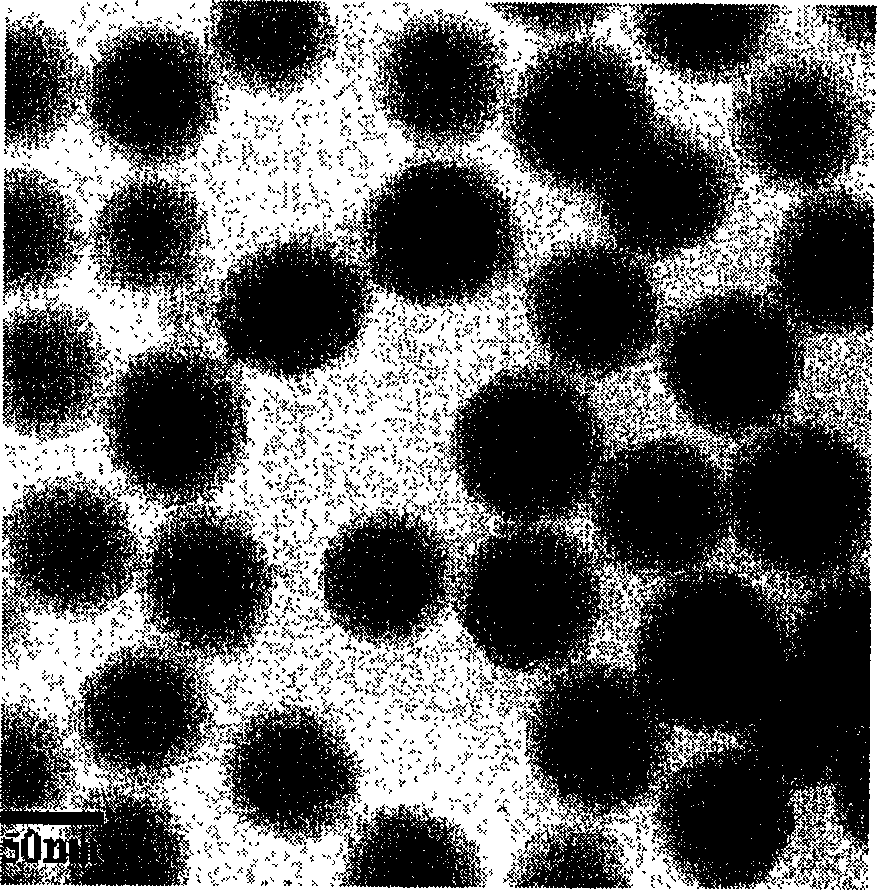Silicon dioxide fluorescent microball containing cadmium telluride fluorescence quantum point
A technology of cadmium telluride quantum dots and fluorescent quantum dots, applied in chemical instruments and methods, luminescent materials, etc., to achieve clear structure, great application value, and high biocompatibility
- Summary
- Abstract
- Description
- Claims
- Application Information
AI Technical Summary
Problems solved by technology
Method used
Image
Examples
Embodiment 1
[0034] Weigh 1.405g cadmium perchlorate (Cd(ClO 4 ) 2 ·6H 2 O) Add to 150mL deaerated secondary deionized water, then add 0.56mL mercaptoglycerol and 0.12mL thioglycolic acid stabilizer, then adjust its pH value to 11.2 with NaOH aqueous solution to form a solution containing mercapto compounds and cadmium ions. On the other hand, take 30mL of 0.5M sulfuric acid solution and inject it into a container containing 0.39g of aluminum telluride (Al 2 Te 3 ) in the flask, the generated H 2 Put all Te into the above-mentioned cadmium ion solution, stir for 15 minutes, heat and reflux for 10 minutes to 10 days, and obtain a cadmium telluride fluorescent quantum that is co-stabilized with mercaptoglycerol and thioglycolic acid and whose fluorescence emission center peak is between 510 and 650 nanometers. Dot the water solution. Fluorescence spectrum see figure 1 .
Embodiment 2
[0036] Weigh 1.315g cadmium perchlorate (Cd(ClO 4 ) 2 ·6H 2 O) Add to 150mL deoxygenated secondary deionized water, then add 0.55mL mercaptoacetic acid as a stabilizer, adjust its pH to 11.2 to form a solution containing mercapto compounds and cadmium ions. The rest of the steps are the same as in Example 1 to obtain an aqueous solution of cadmium telluride quantum dots that is stable with thioglycolic acid and whose fluorescent emission center peak is between 510 and 650 nanometers.
Embodiment 3
[0038] Weigh 1.031g cadmium chloride (CdCl 2 2.5H 2 O) Add to 150mL deoxygenated secondary deionized water, then add 0.55mL mercaptopropionic acid as a stabilizer, adjust its pH to 11.2 to form a solution containing mercapto compounds and cadmium ions. The rest of the steps are the same as in Example 1 to obtain an aqueous solution of cadmium telluride quantum dots that is stable with mercaptopropionic acid and whose fluorescence emission center peak is between 510 and 650 nanometers.
PUM
| Property | Measurement | Unit |
|---|---|---|
| particle diameter | aaaaa | aaaaa |
| thickness | aaaaa | aaaaa |
| particle diameter | aaaaa | aaaaa |
Abstract
Description
Claims
Application Information
 Login to View More
Login to View More - R&D
- Intellectual Property
- Life Sciences
- Materials
- Tech Scout
- Unparalleled Data Quality
- Higher Quality Content
- 60% Fewer Hallucinations
Browse by: Latest US Patents, China's latest patents, Technical Efficacy Thesaurus, Application Domain, Technology Topic, Popular Technical Reports.
© 2025 PatSnap. All rights reserved.Legal|Privacy policy|Modern Slavery Act Transparency Statement|Sitemap|About US| Contact US: help@patsnap.com



